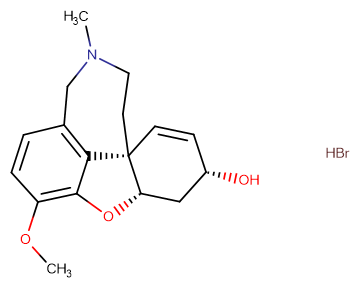
Galanthamine HBr
CAS No. 1953-04-4
Galanthamine HBr ( —— )
Catalog No. M13058 CAS No. 1953-04-4
Galanthamine hydrobromide is a long-acting, centrally active acetylcholinesterase(AChE) inhibitor (IC50 = 410 nM) and allosteric potentiator at neuronal nicotinic ACh receptors.
Purity : >98%(HPLC)
 COA
COA
 Datasheet
Datasheet
 HNMR
HNMR
 HPLC
HPLC
 MSDS
MSDS
 Handing Instructions
Handing Instructions
| Size | Price / USD | Stock | Quantity |
| 25MG | 32 | In Stock |


|
| 50MG | 47 | In Stock |


|
| 100MG | 56 | In Stock |


|
| 500MG | 187 | In Stock |


|
| 1G | Get Quote | In Stock |


|
Biological Information
-
Product NameGalanthamine HBr
-
NoteResearch use only, not for human use.
-
Brief DescriptionGalanthamine hydrobromide is a long-acting, centrally active acetylcholinesterase(AChE) inhibitor (IC50 = 410 nM) and allosteric potentiator at neuronal nicotinic ACh receptors.
-
DescriptionGalanthamine hydrobromide is a long-acting, centrally active acetylcholinesterase(AChE) inhibitor (IC50 = 410 nM) and allosteric potentiator at neuronal nicotinic ACh receptors.
-
Synonyms——
-
PathwayEndocrinology/Hormones
-
TargetAChR
-
RecptorAChE
-
Research AreaNeurological Disease
-
Indication——
Chemical Information
-
CAS Number1953-04-4
-
Formula Weight368.27
-
Molecular FormulaC17H21NO3·HBr
-
Purity>98%(HPLC)
-
SolubilityWater: 36 mg/mL (97.75 mM)
-
SMILESCN1CC[C@@]23C=C[C@@H](C[C@@H]2OC4=C(C=CC(=C34)C1)OC)O.Br
-
Chemical Name——
Shipping & Storage Information
-
Storage(-20℃)
-
ShippingWith Ice Pack
-
Stability≥ 2 years
Reference
1.Thomsen T, et al. Eur J Clin Chem Clin Biochem, 1991, 29(8), 487-492.
molnova catalog


related products
-
BMS-303141
BMS-303141 is a potent ATP-citrate lyase (ACL) inhibitor (IC50: 0.13 uM, human recombinant ACL).
-
Dipivefrin hydrochlo...
Dipivefrin is a prodrug of adrenaline, which is used to treat glaucoma. It is available as ophthalmic solution (eye drops).
-
Hypaphorine
Hypaphorine is an indole-3-acetic acid antagonist which specifically compete with indole-3-acetic acid in binding to the indole-3-acetic acid-binding site in plant peroxidases.



 Cart
Cart
 sales@molnova.com
sales@molnova.com


